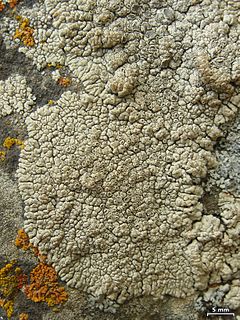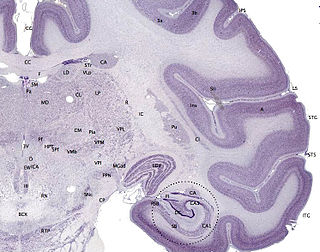Vermilacinia, a genus of lichenized fungi in the family Ramalinaceae, is a yellow-green fruticose type of lichen with about 30 species that grow on rocks, trees, and soil within the fog zone along the Pacific Coast of North America and South America. The genus name refers to the thallus being divided into narrow worm-like (vermis) branches (lacinia);the latter part of the name (lacinia) generally applied in descriptions and taxonomic keys such as exemplified in a key to Sonoran Desert species of Ramalina.

A fruticose lichen is a form of lichen fungi that is characterized by a coral-like shrubby or bushy growth structure. It is composed of a thallus and a holdfast. It is formed from a symbiotic relationship of a photobiont such as cyanobacteria and two mycobionts. Fruticose lichen is composed of a complex vegetation structure, and characterized by an ascending, bushy or pendulous appearance. While lichen communities are mainly controlled by water and light, vegetative dispersal and filamentous growth in fruticose lichen is often associated with areas of low elevation. Fruticose lichens can endure high degrees of desiccation. They grow very slowly and will often occur in extreme habitats such as on tree barks, on rock surfaces and on soils in the Arctic and mountain regions.

Crustose lichens form a crust that strongly adheres to the substrate, making separation from the substrate impossible without destruction. The basic structure of crustose lichens consists of a cortex layer, an algal layer, and a medulla. The upper cortex layer is differentiated and is usually pigmented. The algal layer lies beneath the cortex. The medulla fastens the lichen to the substrate and is made up of fungal hyphae. The surface of crustose lichens is characterized by branching cracks that periodically close in response to climatic variations such as alternate wetting and drying regimes.

Lichens are grouped by common lichen growth forms. There are a wide range of growth forms (morphology). These groupings may not be consistent with lichen taxonomy, since lichens with similar growth forms are not necessarily related by ancestry. Groups based on growth may overlap and have borderline cases. A species usually has the same overall growth form wherever it is found, but not always.

Lichen morphology includes lichen growth forms used to group lichens by "vegetative" thallus types, and forms of "non-vegetative" reproductive parts. Some lichen thalli have the aspect of leaves ; others cover the substrate like a crust, others such as the genus Ramalina adopt shrubby forms, and there are gelatinous lichens such as the genus Collema.
A leprose lichen is a lichen with a powdery or granular surface. Leprose lichens lack an outer "skin," or cortex. If a crustose lichen starts to disintegrate, it will appear powdery, but crustose lichens will leave a cortex surface, and leprose lichens do not. Leprose lichens have no inner or outer cortex. They sometimes have a weak kind of medulla, but are composed mainly of the fungal hyphae and an algae.
A spot test in lichenology is a spot analysis used to help identify lichens. It is performed by placing a drop of a chemical on different parts of the lichen and noting the color change associated with application of the chemical. The tests are routinely encountered in dichotomous keys for lichen species, and they take advantage of the wide array of secondary metabolites produced by lichens and their uniqueness among taxa. As such, spot tests reveal the presence or absence of chemicals in various parts of a lichen. They were first proposed by the William Nylander (botanist) in 1866.

Lecanora muralis is a waxy looking, pale yellowish green crustose lichen that usually grows in rosettes radiating from a center (placoidiod) filled with disc-like yellowish-tan fruiting bodies (apothecia). It grows all over the world. It is extremely variable in its characteristics as a single taxon, and may represent a complex of species. The fruiting body parts have rims of tissue similar to that of the main nonfruiting body (thallus), which is called being lecanorine. It is paler and greener than L. mellea, and more yellow than L. sierrae. In California, it may be the most common member of the Lecanora genus found growing on rocks (saxicolous).

Lobothallia alphoplaca is a creamy gray to brown, placoidioid areolate lichen that grows on rock in on rock and sometimes moss. It prefers growing on siliceous rocks. It is found in Europe, central Asia, and North America, where it grows in the southwestern deserts to central California. The center has numerous crowded and deformed apothecia with rims of thallus-like tissue (lecanorine). With dark reddish or grayish brown to black discs. Lichen spot tests on the thallus and apothecia are C-, and KC-, with tests on the cortex K+ red, P+ orange, or K-, P- and on the medulla K+ red, and P+ orange. It produces norstictic acid, constictic acid, or salazinic acid as secondary metabolites.
Aspicilia pacifica is a white to grayish, brownish, or ocher crustose areolate lichen that commonly grows on siliceous rock or basalt along the seashore and in higher coastal mountains of California and Baja California. It has numerous small, round to angular apothecia toward the middle of the thallus, with concave to flat black discs that are sometimes lightened with white pruina. Lichen spot test on the cortex and medulla are I-, K+ yellow to red, P+ orange, and C-. Secondary metabolites include much stictic acid, and some norstictic acid.
Vermilacinia acicularis is a fruticose lichen that occurs in the Channel Islands of California. The type specimen was collected from San Clemente Island. Other specimens have been collected from Santa Barbara Island and Anacapa Island.
Vermilacinia reptilioderma is a rare fruticose lichen found on the Vizcaíno Peninsula and Cedros Island of Baja California. The epithet, reptilioderma, is in regard to the outer surface of the cortex appearing like the skin of a reptile, especially the brown snake, Pseudechis australis, the color of the thallus cortex often turning brown when stored in a herbarium.
Vermilacinia howei is a fruticose lichen that grows on trees and shrubs in the fog regions along the Pacific Coast of North America in the coastal scrub region of the Channel Islands of California, and around Bahía de San Quintín, Baja California and further south in the Vizcaíno Desert. The epithet is in honor of Reginald Heber Howe, Jr. for his contributions to lichenology, especially acknowledged for providing images of the type (biology) specimens in his revision of the genus Ramalina.
Niebla cornea is a fruticose lichen that grows along the fog regions of the Pacific Coast of North America from near Morro Bay, California to near Punta Santa Rosalillita in Baja California. The epithet, cornea, is in reference to the cortex appearing hard and close textured.
Niebla infundibula is a fruticose lichen that grows on rocks along the Pacific Coast in the Channel Islands of California and in Baja California on Guadalupe Island, and on the main peninsula in the southern region of the Northern Vizcaíno Desert on a ridge south of Punta Negra. The epithet, infundibula, is in reference to the funnel shape of the thallus branches.
Niebla juncosa is a fruticose lichen that grows on rock, stony soil and sand along the Pacific Coast of Baja California from Punta Banda to Morro Santo Dominogo. The epithet, juncosa is in reference to the thallus divided into rush-like branches, the stems of the flowering plant genus Juncus.
Niebla limicola is a fruticose lichen that grows on barren mud flats and on sand among salt scrub along the Pacific Coast of the Vizcaíno Desert, of Baja California from San Vicente Canyon to Scammon’s Lagoon. The epithet, limicola is in reference to the thallus growing on barren (alkali) soil.
Niebla lobulata is a fruticose lichen that grows on rocks in the fog regions along the Pacific Coast of Baja California, from Bahía de San Quintín to Vizcaíno Peninsula and offshore islands, Isla San Martín, and Guadalupe Island. The epithet, lobulata is in reference to the lobed margins of the thallus branches.
Niebla sorocarpia is a fruticose lichen that grows on rocks along the foggy Pacific Coast of California in the Channel Islands and in Baja California in the Northern Vizcaíno Desert. The epithet, sorocarpia, is in reference to the terminal aggregate apothecia.








